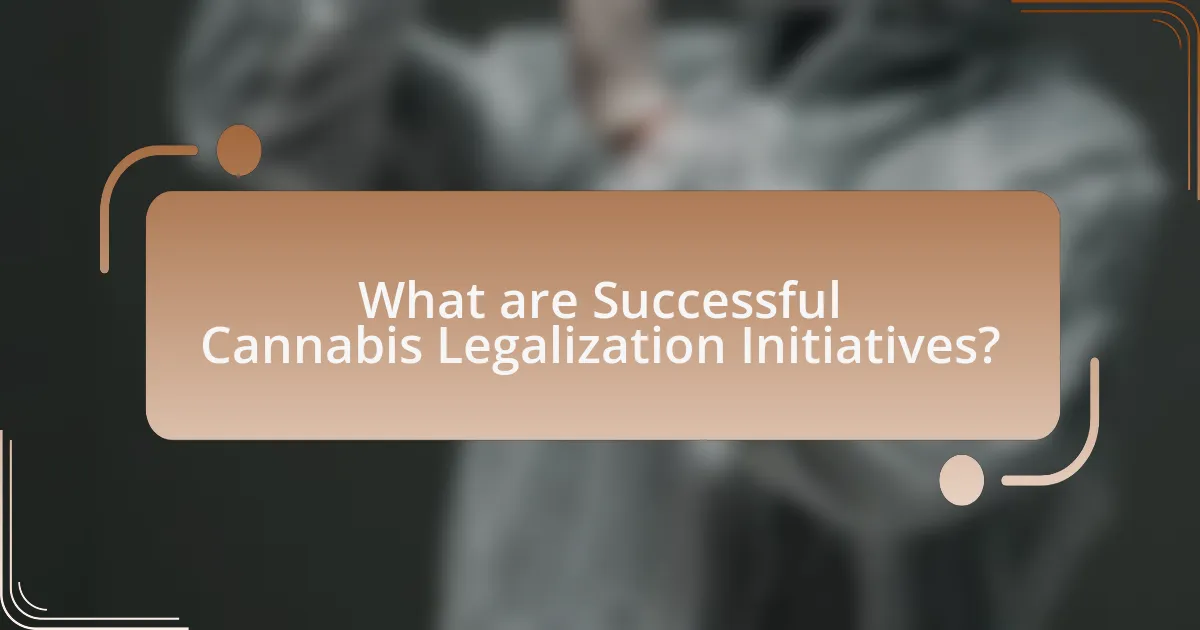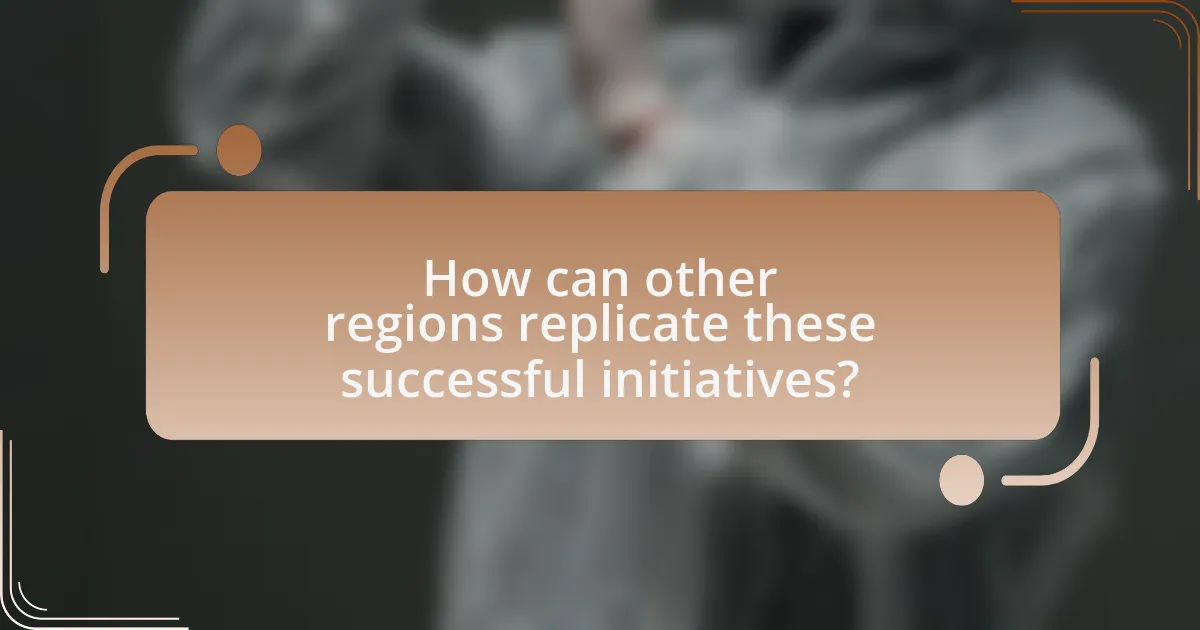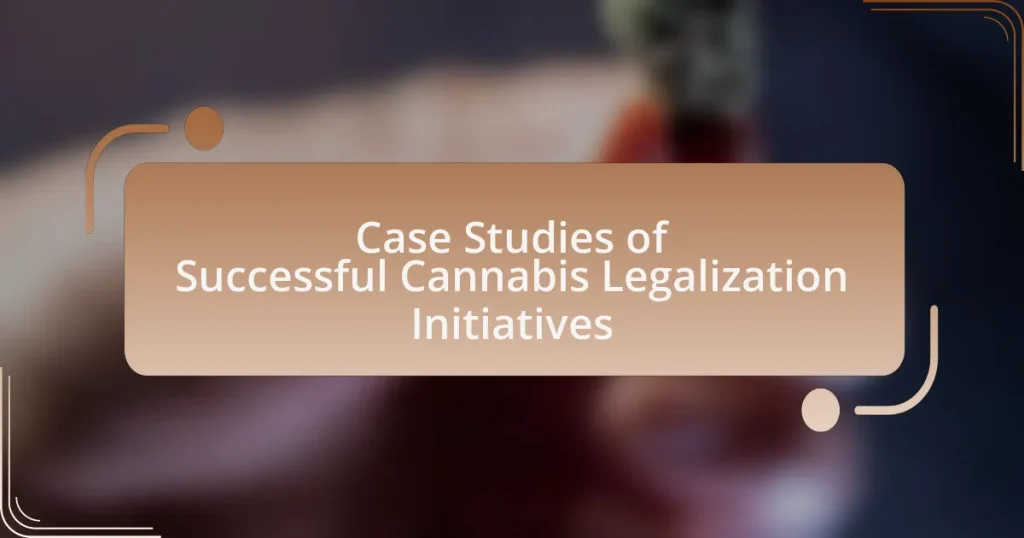The article focuses on case studies of successful cannabis legalization initiatives, highlighting key examples such as Colorado and Canada. It examines the various approaches different regions have taken towards legalization, influenced by cultural and political factors, and identifies critical components that contribute to the success of these initiatives, including public support, regulatory frameworks, and effective advocacy. Additionally, the article discusses the economic impacts of legalization, challenges faced during the process, and best practices for replicating successful models in other regions. It emphasizes the importance of community engagement and education in shaping public opinion and ensuring sustainable legalization efforts.

What are Successful Cannabis Legalization Initiatives?
Successful cannabis legalization initiatives are legislative efforts that have effectively legalized cannabis for recreational or medicinal use, resulting in positive social, economic, and health outcomes. Notable examples include Colorado’s legalization in 2012, which generated over $1.5 billion in tax revenue by 2020 and significantly reduced cannabis-related arrests. Similarly, Canada’s nationwide legalization in 2018 led to a decrease in the black market and increased public health awareness, as evidenced by a 2019 report indicating that 60% of Canadians supported the initiative. These initiatives demonstrate the potential benefits of regulated cannabis markets, including economic growth and improved public safety.
How have different regions approached cannabis legalization?
Different regions have approached cannabis legalization through varying frameworks, often influenced by cultural, political, and economic factors. For instance, in North America, Canada fully legalized cannabis for recreational use in 2018, establishing a regulated market that includes strict quality controls and taxation, which has generated significant government revenue. In contrast, several U.S. states, such as California and Colorado, have legalized cannabis for both medical and recreational use, but federal prohibition remains, creating a complex legal landscape. Meanwhile, countries like Uruguay adopted a state-controlled model, allowing the government to regulate production and distribution, which aims to reduce illegal market activity. These diverse approaches illustrate how regional contexts shape cannabis policy, with varying degrees of regulation and market structure.
What factors contributed to the success of these initiatives?
The success of cannabis legalization initiatives is primarily attributed to strong public support, effective advocacy, and comprehensive regulatory frameworks. Public support has been bolstered by shifting societal attitudes towards cannabis, with surveys indicating that a majority of Americans favor legalization, as evidenced by a Gallup poll showing 68% approval in 2021. Effective advocacy groups, such as the Marijuana Policy Project, have played a crucial role in mobilizing grassroots campaigns and educating voters about the benefits of legalization. Additionally, comprehensive regulatory frameworks that address public health, safety, and taxation have provided a structured approach to legalization, ensuring that initiatives are not only accepted but also sustainable. For instance, Colorado’s legalization in 2012 included a robust regulatory system that generated over $1 billion in tax revenue by 2020, demonstrating the economic viability of such initiatives.
How do public opinions influence legalization efforts?
Public opinions significantly influence legalization efforts by shaping political agendas and legislative actions. When a majority of the public supports a specific legalization initiative, politicians are more likely to advocate for it, as seen in various states where voter polls indicated strong support for cannabis legalization. For example, in 2016, California’s Proposition 64 to legalize recreational cannabis garnered 57.1% of the vote, reflecting widespread public approval that directly impacted the legislative process. Additionally, public opinion can lead to grassroots campaigns that mobilize voters and create pressure on lawmakers, further facilitating the passage of legalization measures.
What are the key components of successful legalization initiatives?
The key components of successful legalization initiatives include comprehensive regulatory frameworks, public support, effective communication strategies, and robust enforcement mechanisms. Comprehensive regulatory frameworks establish clear guidelines for production, distribution, and consumption, ensuring safety and compliance. Public support is crucial, as demonstrated by the 2012 Colorado legalization, where voter approval was over 55%, indicating strong community backing. Effective communication strategies educate the public on the benefits and regulations of legalization, fostering informed decision-making. Lastly, robust enforcement mechanisms ensure adherence to laws and regulations, as seen in states like California, where strict licensing and compliance checks have been implemented to maintain order and safety in the market.
What role do regulatory frameworks play in these initiatives?
Regulatory frameworks are essential in cannabis legalization initiatives as they establish the legal parameters within which the industry operates. These frameworks ensure compliance with safety, quality, and ethical standards, thereby protecting public health and safety. For instance, in states like Colorado, comprehensive regulations have been implemented to govern cultivation, distribution, and sale, which has led to increased tax revenue and reduced illegal market activity. Furthermore, regulatory frameworks facilitate transparency and accountability, allowing for effective monitoring and enforcement of laws, which is crucial for the success of legalization efforts.
How is public health addressed in legalization efforts?
Public health is addressed in legalization efforts through the implementation of regulatory frameworks that prioritize safety, education, and harm reduction. For instance, many jurisdictions that have legalized cannabis have established strict quality control measures to ensure product safety, which helps mitigate health risks associated with unregulated substances. Additionally, public health campaigns are often launched to educate consumers about responsible use and potential health effects, thereby promoting informed decision-making. Research from the National Academies of Sciences, Engineering, and Medicine indicates that regulated markets can reduce the prevalence of cannabis-related health issues by providing safer access and reducing the stigma associated with use.

What lessons can be learned from specific case studies?
Lessons learned from specific case studies of successful cannabis legalization initiatives include the importance of comprehensive regulatory frameworks, public education, and stakeholder engagement. For instance, Colorado’s legalization in 2012 demonstrated that a well-structured regulatory system can lead to increased tax revenue and reduced illegal market activity. Data from the Colorado Department of Revenue indicated that cannabis sales generated over $1.5 billion in revenue by 2020, showcasing the financial benefits of legalization. Additionally, case studies highlight the necessity of addressing public health concerns through education campaigns, as seen in California’s approach, which focused on informing the public about responsible use. Engaging various stakeholders, including law enforcement and community organizations, has proven essential in fostering community support and ensuring successful implementation, as evidenced by the collaborative efforts in Massachusetts. These examples underscore that effective legalization requires a multifaceted strategy that prioritizes regulation, education, and community involvement.
Which countries have successfully legalized cannabis?
Canada, Uruguay, and several U.S. states have successfully legalized cannabis. Canada legalized cannabis for recreational use nationwide in October 2018, becoming the second country in the world to do so after Uruguay, which legalized it in December 2013. In the United States, states like Colorado and California have also legalized cannabis for recreational use, with Colorado being the first state to do so in January 2014. These countries and states have established regulatory frameworks to manage the production, distribution, and sale of cannabis, demonstrating successful legalization initiatives.
What strategies did Canada employ in its legalization process?
Canada employed a comprehensive regulatory framework as a key strategy in its cannabis legalization process. This framework included extensive public consultations, the establishment of a legal age for consumption, and a controlled distribution system to ensure safety and compliance. The government also focused on public health and safety by implementing strict advertising regulations and promoting responsible use. Additionally, Canada utilized a phased approach to legalization, starting with medical cannabis in 2001, which laid the groundwork for the full legalization of recreational cannabis in 2018. This gradual implementation allowed for adjustments based on feedback and outcomes, reinforcing the effectiveness of the strategies employed.
How did Uruguay’s approach differ from other countries?
Uruguay’s approach to cannabis legalization differed from other countries by implementing a state-controlled model that allows for regulated production, distribution, and consumption. Unlike countries such as Canada and various U.S. states that primarily focus on commercial markets, Uruguay’s system emphasizes public health and safety, with the government overseeing all aspects of cannabis from cultivation to sale. This model includes provisions for home cultivation and cooperative growing, which contrasts with the profit-driven motives seen in other jurisdictions. Uruguay’s legislation, enacted in 2013, was the first of its kind globally, aiming to reduce drug-related crime and promote responsible use, showcasing a unique public health-oriented strategy rather than a purely economic one.
What challenges did these countries face during legalization?
Countries faced several challenges during cannabis legalization, including regulatory hurdles, public health concerns, and social stigma. Regulatory hurdles involved creating comprehensive legal frameworks that addressed production, distribution, and consumption, which required extensive collaboration among various government agencies. Public health concerns revolved around the potential increase in usage rates, particularly among youth, prompting debates on how to implement effective education and prevention programs. Social stigma persisted as many communities remained opposed to legalization, complicating efforts to gain public support and acceptance. These challenges were evident in countries like Canada and Uruguay, where initial resistance and the need for robust regulatory systems delayed the implementation of legalization measures.
How did they overcome opposition from various stakeholders?
They overcame opposition from various stakeholders by engaging in comprehensive dialogue and building coalitions. Successful cannabis legalization initiatives often involved stakeholders such as law enforcement, healthcare professionals, and community leaders, who were initially resistant. By presenting data on the economic benefits, such as projected tax revenues and job creation, advocates were able to shift perceptions. For instance, in Colorado, the legalization campaign highlighted the potential for significant tax revenue, which was projected to exceed $100 million annually, thereby addressing fiscal concerns of local governments. Additionally, educational campaigns that focused on public health and safety helped alleviate fears, demonstrating that regulated cannabis markets could reduce illegal sales and improve safety.
What were the economic impacts of legalization in these regions?
The economic impacts of legalization in regions such as Colorado and Washington included significant increases in tax revenue, job creation, and reductions in law enforcement costs. For instance, Colorado generated over $1.5 billion in tax revenue from cannabis sales between 2014 and 2020, which funded education, healthcare, and infrastructure projects. Additionally, the legalization led to the creation of tens of thousands of jobs in the cannabis industry, contributing to lower unemployment rates. Furthermore, law enforcement expenditures related to cannabis offenses decreased, allowing for reallocation of resources to other public safety initiatives. These outcomes demonstrate the positive economic effects of cannabis legalization in these regions.

How can other regions replicate these successful initiatives?
Other regions can replicate successful cannabis legalization initiatives by adopting evidence-based policies, engaging stakeholders, and implementing regulatory frameworks tailored to local contexts. For instance, regions should analyze data from successful case studies, such as Colorado’s legalization in 2012, which generated over $1 billion in tax revenue by 2020, demonstrating the economic benefits of a well-regulated market. Additionally, involving community members, law enforcement, and health professionals in the planning process fosters public support and addresses concerns, as seen in California’s approach, which emphasized public health and safety. By learning from these examples and adapting strategies to fit their unique social, economic, and legal landscapes, other regions can effectively implement similar initiatives.
What best practices can be derived from successful case studies?
Best practices derived from successful case studies of cannabis legalization initiatives include comprehensive stakeholder engagement, evidence-based policy formulation, and robust regulatory frameworks. Comprehensive stakeholder engagement ensures that diverse perspectives, including those of community members, law enforcement, and health professionals, are considered, leading to more inclusive and effective policies. Evidence-based policy formulation relies on data and research to guide decisions, as seen in Colorado’s approach, which utilized extensive studies to inform its regulatory measures. Robust regulatory frameworks, exemplified by California’s structured licensing system, help maintain industry standards and public safety while fostering economic growth. These practices collectively contribute to the successful implementation and sustainability of cannabis legalization initiatives.
How can community engagement enhance legalization efforts?
Community engagement can enhance legalization efforts by fostering public support and creating a sense of ownership among stakeholders. Engaged communities are more likely to advocate for policies that reflect their needs and values, which can lead to increased voter turnout and support for legalization initiatives. For instance, in states like Colorado and Washington, grassroots campaigns that involved community members significantly contributed to the successful passage of legalization measures. Research indicates that when communities actively participate in the legislative process, they can influence policy outcomes, as seen in the 2012 Colorado Amendment 64 campaign, where local advocacy groups mobilized citizens to support legalization, resulting in a 55% approval rate.
What role does education play in the success of legalization initiatives?
Education plays a crucial role in the success of legalization initiatives by informing the public about the benefits and risks associated with legalization. In states like Colorado and Washington, comprehensive educational campaigns helped to shift public perception, leading to increased support for cannabis legalization. For instance, a 2014 survey by the Colorado Department of Public Health and Environment indicated that 70% of respondents felt more informed about cannabis due to educational efforts, which directly correlated with the successful passage of legalization measures. Furthermore, education helps dispel myths and misinformation, fostering a more informed electorate that can make decisions based on facts rather than fear.
What are the common pitfalls to avoid in cannabis legalization?
Common pitfalls to avoid in cannabis legalization include inadequate regulatory frameworks, which can lead to inconsistent enforcement and public safety issues. For instance, jurisdictions that fail to establish clear guidelines for cultivation, distribution, and sales often experience increased illegal market activity. Additionally, insufficient public education campaigns can result in misinformation and stigma surrounding cannabis use, hindering acceptance and compliance. A lack of stakeholder engagement, particularly with communities disproportionately affected by past cannabis prohibition, can also lead to social equity issues and community pushback. Lastly, overlooking the importance of taxation and revenue allocation can create financial shortfalls that undermine the sustainability of legalized cannabis programs. These pitfalls have been observed in various case studies, such as in California, where regulatory challenges have persisted since legalization in 2016, highlighting the need for comprehensive planning and community involvement.
How can mismanagement of resources hinder legalization efforts?
Mismanagement of resources can significantly hinder legalization efforts by diverting funds and attention away from essential advocacy and regulatory activities. For instance, when financial resources are poorly allocated, critical areas such as public education campaigns, legal support, and community engagement suffer, leading to a lack of public support and understanding of legalization benefits. A study by the Drug Policy Alliance highlights that states with well-funded and strategically managed legalization campaigns saw higher voter approval rates, demonstrating that effective resource management is crucial for garnering public support and ensuring successful implementation of legalization initiatives.
What lessons can be learned from unsuccessful legalization attempts?
Unsuccessful legalization attempts reveal critical lessons about the importance of public education, stakeholder engagement, and addressing social equity concerns. For instance, initiatives that failed often lacked comprehensive outreach to inform the public about the benefits and regulations of legalization, leading to misinformation and fear. Additionally, unsuccessful efforts frequently did not involve key stakeholders, such as law enforcement and community leaders, which resulted in resistance and lack of support. Furthermore, many failed attempts overlooked the need to incorporate social equity measures, failing to address the disproportionate impact of past cannabis prohibition on marginalized communities. These factors highlight the necessity of a well-rounded approach that includes education, collaboration, and equity to enhance the chances of successful legalization.
What practical steps can advocates take to promote legalization?
Advocates can promote legalization by organizing grassroots campaigns that mobilize community support and raise awareness about the benefits of legalization. These campaigns can include educational workshops, public forums, and social media outreach to inform the public about the economic, social, and health-related advantages of legalization. For instance, a study by the Drug Policy Alliance highlights that states with legalized cannabis have seen significant tax revenue increases, which can be used for public services. Additionally, advocates can collaborate with local businesses and organizations to create coalitions that support legalization efforts, demonstrating broad community backing. Engaging in lobbying efforts to influence policymakers and participating in public hearings can also amplify their message and push for legislative change.


